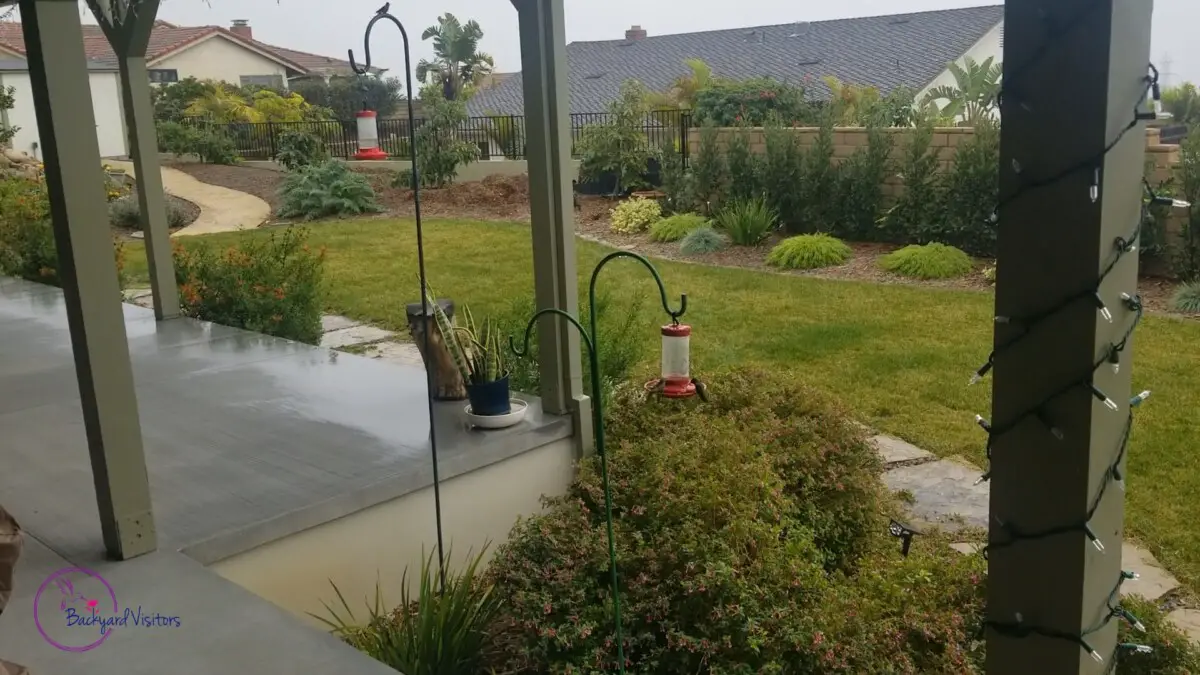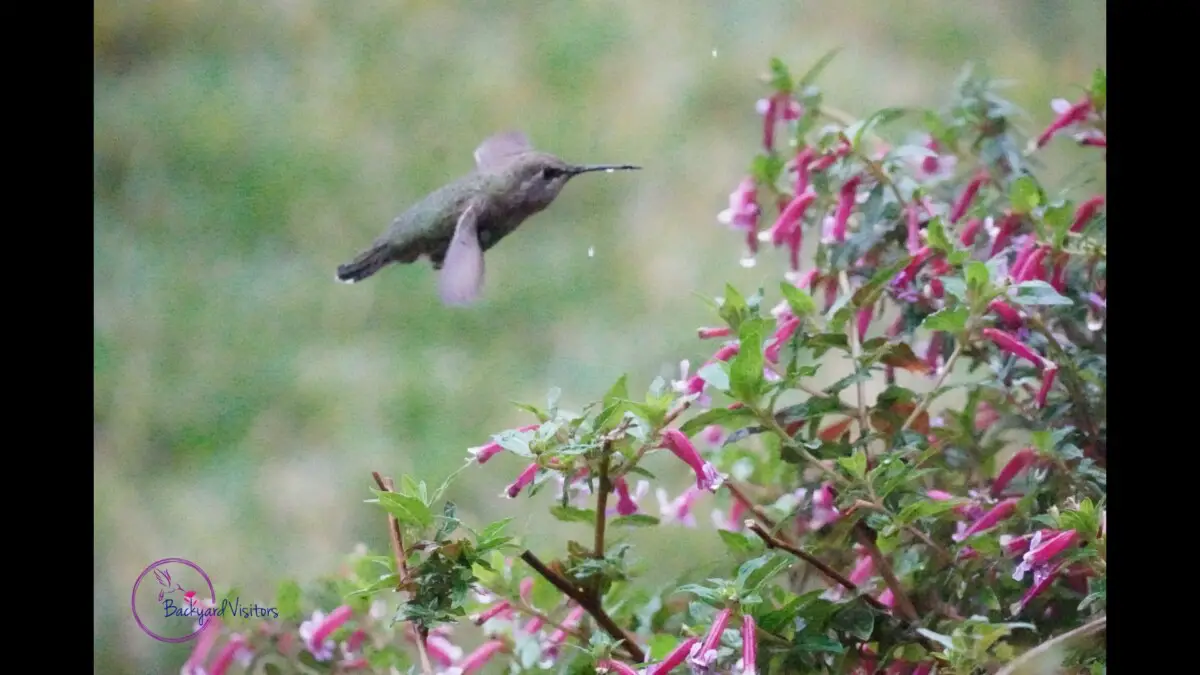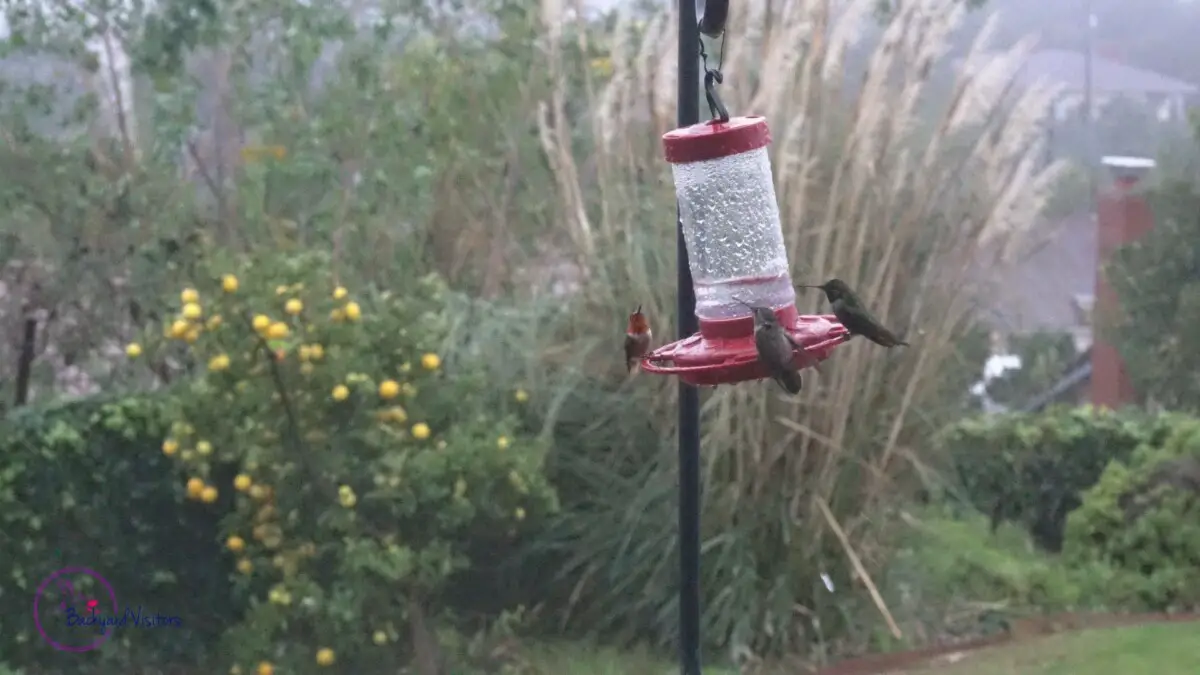This post contains affiliate links.
I was quite surprised to see my hummingbird feeders with all 12 ports occupied during the recent heavy downpour of rain. There were hummingbirds waiting to get to the feeder once a port became available.
The downpour was extremely heavy, and it caused me to wonder how that much rain would affect their flying ability.
This is what I learned.
Do Hummingbirds Fly In The Rain?
Hummingbirds can and do fly in light to very heavy rain. In light to moderate rain they shake off water but in heavy rain they need to adjust their body vertically to compensate. Wing speed is also altered depending on rain intensity. The amount of compensation depends on the size of the hummingbird.
Hummingbirds, those delightful little birds I love to watch, can indeed fly in the rain. While they may appear delicate, hummingbirds are resilient creatures that carry on with their usual activities even when it’s raining lightly or during moderate showers. In fact, a light shower can provide them with a refreshing break from the heat while conserving their energy.

They continue their activities as if they were not raining.
As the rain becomes a bit heavier, hummingbirds tend to seek shelter in more protected spots. They may prefer to use feeders or look for food sources that are shielded from the rain. However, even in heavy rainfall, they won’t let it stop them from taking to the skies.
When the rain gets heavier and starts pouring, hummingbirds fill up their bellies and then seek refuge for as long as they can before they need to eat again.
Below is a video of hummingbirds visiting my feeders in light and heavy rain.
They were a delight to watch as they competed for an open port to fill their bellies,
They search for any spot that keeps them safe from the elements, such as below tree leaves or shrubs on the downwind side of the tree or shrub. They firmly grip onto thin branches with their feet and wait for the rain to subside.
During the day, if the weather turns particularly bad, hummingbirds may enter a sleep-like state called “torpor” to conserve energy while not actively feeding. However, most of the time, they simply perch and patiently wait for the rain to stop. As soon as the rain softens, they quickly resume their usual routine of flying and feeding.

vertical body position in heavy rain.
Hummingbirds have unique adaptations that allow them to repel water from their feathers to a certain extent. The shape of their feathers and the self-produced natural oils they distribute during preening help them stay relatively dry.
Their feathers repel water to some extent, however, are not entirely waterproof.
They can even shake off almost all the rain from their plumage in just one-tenth of a second, both when they are at rest and in flight. This quick movement may not even be visible to the human eye and was only discovered through slow-motion videos.
Scientists have observed hummingbirds in different levels of rainfall and found that they can maintain their regular flight in light rain. However, in heavy rain, they adjust their body position and wing speed to navigate through it. The raindrops themselves don’t harm the birds or cause them any injury.
To stay dry during severe storms or hurricanes, hummingbirds are quite resourceful. They seek out sheltered spots on the downwind side of tree trunks, protected by surrounding vegetation or other features. This allows them to brave even the most extreme weather conditions without getting harmed.
Creating a hummingbird-friendly garden can greatly contribute to their well-being during rainy weather. By having plants that provide nectar for them, attracting insects they like to eat, and including features like fresh water for bathing and plenty of shrubs and trees for shelter, you can help these delightful creatures thrive.
You can read more about creating a hummingbird-friendly area by reading my article:
Increase Backyard Hummingbird Activity in 7 Days or Less
Where do hummingbirds go during the rain?
During rain, hummingbirds seek shelter in dense vegetation on the downwind side of tree trunks, perching on branches with strong feet. They may also find refuge in nests or protected areas like covered porches or eaves. In heavy rain, they may even enter torpor to wait out the storm.
Hummingbirds adapt to the weather in unique ways when it rains. They appear delicate, but they are actually rather tough. Hummingbirds go about their routine of flying and feeding even in mild or moderate rain. They can even take a brief shower to cool off and preserve energy while getting some reprieve from the heat.
Hummingbirds will, however, seek refuge as it starts to rain more heavily, but first they will fill their bellies to stay warm while waiting out the storm. They will either discover protected food sources or employ feeders to quickly fill their stomachs.
Expect a rush to your feeders during the start of a heavy downpour.
That is what I experienced at my feeders during the start of very heavy rainfall.
Below is my YouTube video of the rush of hummingbirds to my feeders at the start of a rainstorm.
Adult hummingbirds may perch and wait for the rain to subside during periods of heavy precipitation or severe storms. They seek protected areas on the downwind side of trees or shrubs, clinging onto thin branches with their feet and hiding beneath the leaves. However, they typically wait until the rain subsides before flying and feeding once more. Occasionally, they may enter a dormant state called “torpor” to conserve energy.
To prevent excessive water absorption, they increase the number of wing beats per second, alter the angle of their wings, and even alter their body position.
You can read more about creating a hummingbird-friendly area by reading my article:
Increase Backyard Hummingbird Activity in 7 Days or Less
Is it hard for hummingbirds to fly in the rain?
It is difficult for hummingbirds to fly in heavy rain due to their small size and delicate feathers, but light to moderate rain has only a minor effect on their ability to fly. They adapt to heavy rain with increased wing speed, wing maneuvering, and a more horizontal body position in flight.
When it comes to rain, hummingbirds have different behaviors depending on the intensity of the rainfall.
In light to moderate rain during flight, they simply shake off the water, much like a dog, but it is done so quickly that it can only be seen in slow-motion video.
In heavy rain, they change their body position in flight from horizontal to more vertical so the water “rolls off their back”.
Hummingbirds, despite their small size, are remarkably capable of flying in the rain. They have developed various adaptations that allow them to handle rain without much difficulty.
The smaller the hummingbird, the more difficulty it will have flying in the rain.
In light rain and moderate showers, hummingbirds carry on with their usual activities, such as feeding and searching for food. They may even find the rain refreshing and enjoy the opportunity to fly and feed without using too much energy. During these conditions, they might seek sheltered spots and use feeders or protected food sources, but overall, their ability to fly is not hindered.
However, when the rain becomes heavy, hummingbirds seek shelter, but not before they fill their bellies to wait out the storm. They will flock to your feeders to fill their bellies as quickly as possible, then find protected spots where they can perch and wait for the storm to pass.
They seek shelter on the downwind side of a tree or bush, hiding on thin branches below some foliage. They may also enter a dormant state called “torpor” to conserve energy, even during the day if the storm is prolonged.
While heavy rain does require more energy for hummingbirds to fly due to the water soaking their feathers, they have adaptations to compensate for this. They can adjust their flight by increasing their wing beats per second and altering the angle of their wings and bodies. This helps reduce the amount of water on their bodies. However, it’s important to note that hummingbirds generally prefer to avoid flying in heavy rain altogether and will wait for the rain to subside before resuming their activities.
Hummingbird feathers are designed to shed water, and they distribute their self-produced natural oils during preening, which help repel water to some extent. Additionally, they can shake off water by rapidly moving their feathers back and forth, effectively removing rain from their plumage in a fraction of a second. Even in heavy rain, the raindrops themselves do not harm the birds.
Hummingbirds do survive severe storms and hurricanes, clinging tightly to twigs or other perches, even hanging upside down without letting go. Hummingbirds have been observed feeding on hummingbird feeders, even within the eye of a storm.
Overall, while flying in the rain does pose some challenges for hummingbirds, they have developed unique adaptations to handle these conditions. Their ability to adjust their flight posture, increase wing-beat frequency, and shake off water allows them to continue flying and feeding even in rainy weather.
Hummingbirds’ small and light bodies, along with their specialized flight strategies, further contribute to their remarkable flying abilities. Hummingbirds are truly exceptional creatures that have adapted well to survive and thrive in various weather conditions.
When it comes to rain, hummingbirds have different behaviors depending on the intensity of the rainfall.
The smaller the hummingbird, the more difficulty it will have flying in the rain.
Despite their diminutive size, hummingbirds can fly in the rain with remarkable skill. They have evolved a number of adaptations that make it easy for them to deal with rain.
Light to Moderate Rain:
If it is raining lightly to moderately while they are in the air, they just shake off the precipitation like a dog, but they do it so swiftly that it can only be captured on camera in slow motion.
In light rain and moderate showers, hummingbirds carry on with their usual activities, such as feeding and searching for food. They may even find the rain refreshing and enjoy the opportunity to fly and feed without using too much energy.
They might even love the rain and find it invigorating.

Notice this hummingbird’s horizontal body position in light rain.
In heavy rain, the body position in flight is more vertical.
During these conditions, they might seek sheltered spots and use feeders or protected food sources, but overall, their ability to fly is not hindered.
Heavy Rain:
In heavy rain, they shift their body position in flight from horizontal to more vertical so that the water “rolls off their backs.”
While heavy rain does require more energy for hummingbirds to fly due to the water soaking their feathers, they have adaptations to compensate for this. They can adjust their flight by increasing their wing beats per second and altering the angle of their wings and bodies. This helps reduce the amount of water on their bodies. However, it’s important to note that hummingbirds generally prefer to avoid flying in heavy rain altogether and will wait for the rain to subside before resuming their activities.
Hummingbird feathers are designed to shed water, and they distribute their self-produced natural oils during preening, which help repel water to some extent. Additionally, they can shake off water by rapidly moving their feathers back and forth, effectively removing rain from their plumage in a fraction of a second. Even in heavy rain, the raindrops themselves do not harm the birds.
Hummingbirds’ small and light bodies, along with their specialized flight strategies, further contribute to their remarkable flying abilities. Hummingbirds are truly exceptional creatures that have adapted well to survive and thrive in various weather conditions.
Do Hummingbirds Know When a Storm is Coming?
Hummingbirds possess an innate instinct that allows them to anticipate and prepare for the arrival of an approaching storm. Through their keen perception and sensitivity to changes in atmospheric pressure, temperature, wind patterns, and other cues, they seek shelter and protect themselves.
Hummingbirds possess a remarkable ability to sense and respond to impending storms. When bad weather approaches, they instinctively seek shelter in the most protected areas they can find, often amidst dense vegetation on the downwind side of a tree trunk. This behavior indicates that they have some knowledge or instinct that enables them to sense when a storm is approaching.
Despite their small size, hummingbirds have advantages over larger birds when it comes to escaping the wind. Their relatively small size and minimal surface area make it easier for them to navigate away from gusts of wind and seek refuge. They also have strong feet that enable them to tightly grip onto twigs even in strong winds, helping them stay in place and withstand the storm.

in heavy wind and rain, filling their bellies
before seeking shelter to ride out the storm.
In areas prone to hurricanes, some dedicated hummingbird enthusiasts take precautions by securing their feeders with wire or duct tape before the storm arrives. This ensures that the hummingbirds can access sugar water whenever the conditions allow. However, it is important to remove the duct tape after the storm to prevent the birds from getting stuck to it.
It’s worth noting that while hummingbirds can endure hurricanes over land, they face greater risks during migration, particularly when encountering northbound winds in the Gulf of Mexico. Unexpected winds can be fatal for hummingbirds that venture into hurricanes during migration.
Check out my other posts on Hummingbird Questions
Happy Hummingbird Watching In The Rain!
Backyard Visitors participates in affiliate programs which compensate us for referring traffic.
